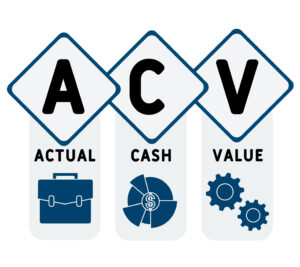
In Lahaina, Hawaii more than 2,000 homes were destroyed during a fire. In Mayfield, Kentucky, 3,778 homes were damaged or destroyed in a tornado. More than 63,500 houses were destroyed during Hurricane Andrew.
Your home is one weather event away from being a statistic. Before that happens, you need to pull out your property policy and read it. Even better, you need to understand it. The only thing worse than getting a full insurance payout and still coming up $200,000 short to rebuild is not getting a payout at all.
Understanding the Actual Cash Value Method
The weakest type of coverage is where the insurance payout for your property is calculated using the actual cash value (“ACV”) method. This is determined by subtracting the depreciated use from the current cost of replacement. The ACV method does not make you whole after the loss because it fails to provide you with enough money to replace your property. And the payout only gets worse as your home ages because the depreciation has increased.

While you may get a discount on the premium for using ACV, this type of policy gives you poor results if you do need to file a claim. If you own property that does not conform to current building codes, then you will get even worse results. ACV = bad choice.
Why Replacement Cost Coverage Is Worth It
Replacement cost coverage (“RCV”) is a much better choice. It covers the cost of replacing the property with reducing the payout for depreciation. RCV is based on what it would cost in today’s market to replace the damaged property, without taking into consideration the condition of the property at the time of the loss. The word “depreciation” does not cross your adjuster’s lips. You will still have to pay the deductible, but at least you have a fighting chance to get a comparable home.
 But – and this is a biggie– with RCV the insurance company may make it difficult for you to complete construction by engaging in a two-step settlement process. In the first step, the company pays for repairs based on the ACV method, deducting for depreciation. The second step, where the company pays for the difference between the ACV and RCV, is only done after the construction is completed and you submit the actual invoices. That means you must front the difference for construction costs, and then fight for reimbursement.
But – and this is a biggie– with RCV the insurance company may make it difficult for you to complete construction by engaging in a two-step settlement process. In the first step, the company pays for repairs based on the ACV method, deducting for depreciation. The second step, where the company pays for the difference between the ACV and RCV, is only done after the construction is completed and you submit the actual invoices. That means you must front the difference for construction costs, and then fight for reimbursement.
Is that fair? No, but you may need to hire a lawyer to sort through the issues.
What To Review In Your Home Insurance Policy
After you’ve checked your policy to make sure your coverage is RCV and not ACV, you need to turn to written exclusions and limitations. One common exclusion is for loss amounts from “ordinance and law.” In Texas, the building, zoning, or land use ordinance or law is found in the International Residential Code. If your rebuild was supposed to include an upgrade because it is required by an ordinance, but your local authority did not actually take steps to enforce the ordinance, then the insurance company may take the position that it does not have to reimburse you the cost of the upgrade.
Also note the deductibles for the policy. You can find information about them on the declarations page, and then further descriptions within the policy itself. You may want to use a calculator to add up all the deductibles you would need to pay if your home was destroyed.
Visit the Texas Department of Insurance website for more information:
It’s better to know the worst now, while you can still change insurance policies.
Hammerle Finley Can Help With Your Real Estate Questions
Should you need legal assistance involving real estate matters, schedule a consultation with one of our experienced lawyers to explore your options.
Attorney Virginia Hammerle, of Hammerle Finley Law Firm, is in her fifth decade of law practice. She is Board Certified in Civil Trial Law and an Accredited Estate Planner. Reach her at legaltalktexas@hammerle.com. This column does not constitute legal advice.







